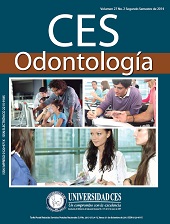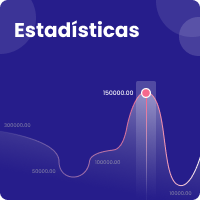Efectos de los aparatos propulsores mandibulares fijos en la articulación temporomandibular
Resumen
Los aparatos propulsores mandibulares fijos son una alternativa en el tratamiento de la maloclusión Clase II con deficiencia mandibular. La propiedad de ser fijo, condiciona a la mandíbula a una posición anterior forzada en reposo y durante todas las funciones mandibulares. Cuando se utiliza un aparato de propulsión, la mandíbula se desplaza hacia delante y hacia abajo. Este movimiento conduce a una nueva posición al cóndilo, que puede afectar el funcionamiento normal de la articulación temporomandibular (ATM). El objetivo de este trabajo fue realizar una revisión de tema sobre los efectos de los aparatos propulsores mandibulares fijos en la ATM. Fueron incluidos estudios con animales o estudios con seres humanos,utilizando radiografías de la ATM, electromiografía postural, tomografía computarizada y resonancia magnética. Los estudios confirman una relación favorable entre el cóndilo y la cavidad glenoidea después de un tratamiento con aparatos fijos de propulsión mandibular.
Descargas
Los datos de descargas todavía no están disponibles.
Referencias bibliográficas
1. Angle EH. Classification of malocclusion. Dent. Cosm. 1899;41:248–264.
2. McNamara JAJ. Components of Class II Malocclusion in Children 8-10 Years of Age. Angle Orthod.
1981;51(3):177–202.
3. Capelozza L, Gonçalves ALCA, Leal LM, Siqueira DF, Castro RCFR, Cardoso MDA. Aparelho de
protração mandibular Forsus no tratamento das más oclusões do Padrão II : relato de caso clínico. Rev
Clin Ortod Dent. Press 2012;11(1):79–91.
4. Silva Filho OG, Mendes OF, Aiello CA, Okada T. O Aparelho Herbst e as Alterações Adaptativas na
ATM : Revisão de Literatura. J Bras Ortodon Ortop Facial 2002;7(41):426–437.
5. Aelbers CMF, Dermaut LR. Orthopedics in orthodontics: Fiction or reality-A review of the literature
Part I. Am. J. Orthod. Dentofac. Orthop. 1996;110(6):513–519.
6. Ruf S, Wüsten B, Pancherz H. Temporomandibular joint effects of activator treatment: a prospective
longitudinal magnetic resonance imaging and clinical study. Angle Orthod. 2002;72(6):527–540.
7. Pereira APS, Almeida KCM, Raveli DB, Maia S, Palomino-Gómez SP. Tratamento da má-oclusão de
Classe II divisão 1 de Angle, com aparelho de Herbst splint metálico seguido de aparelho fixo, na dentição
permanente. Ortod. SPO 2011;44(6):561–570.
8. Vargervik K, Harvold EP. Response to activator treatment in Class II. Am. J. Orthod. Dentofac. Orthop.
1985;88:242–251.
9. Woodside DG, Metaxas A, Altuna G. The influence of functional appliance therapy on glenoid fossa
remodeling. Am. J. Orthod. 1987;92(3):181–198.
10. Hinton RJ, McNamara JAJ. Effect of age on the adaptive Response of the adult temporomandibular
joint. Angle Orthod. 1984;54(2):154–162.
11. Hinton RJ, McNamara JAJ. Temporal bone adaptations in response to protrusive function in juvenile
and young adult rhesus monkeys (Macaca mulatta). Eur. J. Orthod. 1984;6:155–174.
12. McNamara JAJ, Bryan F. Longterm mandibular adaptations to protrusive function: an experimental
study in Macaca mulatta. Am J Orthod 1987;92(2):98–108.
13. Sessle BJ, Woodside DG, Bourque P, et al. Effect of functional appliances on jaw muscle activity. Am.
J. Orthod. Dentofac. Orthop. 1990;98(3):222–230.
14. McNamara JA, Peterson JE, Pancherz H. Histologic Changes Associated With the Herbst Appliance
in Adult Rhesus Monkeys ( Macaca mulatta ). Semin. Orthod. 2003;9(1):26–40.
15. Rabie ABM, Chayanupatkul A, Hagg U. Stepwise advancement using fixed functional appliances:
Experimental perspective. Semin. Orthod. 2003;9(1):41–46.
16. Voudouris JC, Woodside DG, Altuna G, Kuftinec MM, Angelopoulos G, Bourque PJ. Condyle-fossa
modifications and muscle interactions during herbst treatment, part 1. new technological methods. Am.
J. Orthod. Dentofac. Orthop. 2003;123(6):604–613.
17. Voudouris JC, Woodside DG, Altuna G, Angelopoulos G, Bourque PJ, Lacouture CY. Condyle-fossa
modifications and muscle interactions during Herbst treatment, Part 2. Results and conclusions. Am. J.
Orthod. Dentofac. Orthop. 2004;124(1):13–29.
18. Ruf S, Pancherz H. Temporomandibular joint growth adaptation in Herbst treatment: a prospective
magnetic resonance imaging and cephalometric roentgenographic study. Eur. J. Orthod. 1998a;20(4):375–
388.
19. Ruf S, Pancherz H. Long-term TMJ effects of Herbst treatment: a clinical and MRI study. Am. J.
Orthod. Dentofacial Orthop. 1998a;114(5):475–483.
20. Ruf S, Pancherz H. Temporomandibular joint remodeling in adolescents and young adults during
Herbst treatment: A prospective longitudinal magnetic resonance imaging and cephalometric radiographic
investigation. Am. J. Orthod. Dentofacial Orthop. 1999;115(6):607–618.
21. Pancherz H, Ruf S, Thomalske-Faubert C. Mandibular articular disk position changes during Herbst
treatment: a prospective longitudinal MRI study. Am. J. Orthod. Dentofac. Orthop. 1999;116(2):207–214.
22. Kinzinger GSM, Roth A, Gülden N, Bücker A, Diedrich PR. Effects of orthodontic treatment with
fixed functional orthopaedic appliances on the disc-condyle relationship in the temporomandibular joint: a
magnetic resonance imaging study (Part II). Dentomaxillo facial Radiol. 2006;35:347–356.
23. Kinzinger G, Roth A, Gülden N, Bücker A, Diedrich P. Effects of orthodontic treatment with fixed
functional orthopaedic appliances on the disc-condyle relationship in the temporomandibular joint: a
magnetic resonance imaging study (Part I). Dentomaxillofac. Radiol. 2006;35:339–346.
24. Aidar LADA, Dominguez GC, Yamashita HK, Abrahão M. Changes in temporomandibular joint disc
position and form following Herbst and fixed orthodontic treatment. Angle Orthod. 2010;80(5):843–852.
25. Aras A, Ada E, Saracoglu H, Gezer NS, Aras I. Comparison of treatments with the Forsus fatigue
resistant device in relation to skeletal maturity: a cephalometric and magnetic resonance imaging study.
Am. J. Orthod. Dentofacial Orthop. 2011;140(5):616–625.
26. Hansen K, Pancherz H, Petersson A. Long-term effects of the Herbst appliance on the craniomandibular
system with special reference to the TMJ. Eur. J. Orthod. 1990;12:244–253.
27. Paulsen HU. Morphological changes of the TMJ condyles of 100 patients treated with the Herbst
appliance in the period of puberty to adulthood: A long-term radiographic study. Eur. J. Orthod.
1997;19(6):657–668.
28. Arici S, Akan H, Yakubov K, Arici N. Effects of fixed functional appliance treatment on the
temporomandibular joint. Am. J. Orthod. Dentofac. Orthop. 2008;133(6):809–814.
29. LeCornu M, Cevidanes LHS, Zhu H, Wu C-D, Larson B, Nguyen T. Three-dimensional treatment
outcomes in Class II patients treated with the Herbst appliance: a pilot study. Am. J. Orthod. Dentofac.
Orthop. 2013;144(6):818–830.
2. McNamara JAJ. Components of Class II Malocclusion in Children 8-10 Years of Age. Angle Orthod.
1981;51(3):177–202.
3. Capelozza L, Gonçalves ALCA, Leal LM, Siqueira DF, Castro RCFR, Cardoso MDA. Aparelho de
protração mandibular Forsus no tratamento das más oclusões do Padrão II : relato de caso clínico. Rev
Clin Ortod Dent. Press 2012;11(1):79–91.
4. Silva Filho OG, Mendes OF, Aiello CA, Okada T. O Aparelho Herbst e as Alterações Adaptativas na
ATM : Revisão de Literatura. J Bras Ortodon Ortop Facial 2002;7(41):426–437.
5. Aelbers CMF, Dermaut LR. Orthopedics in orthodontics: Fiction or reality-A review of the literature
Part I. Am. J. Orthod. Dentofac. Orthop. 1996;110(6):513–519.
6. Ruf S, Wüsten B, Pancherz H. Temporomandibular joint effects of activator treatment: a prospective
longitudinal magnetic resonance imaging and clinical study. Angle Orthod. 2002;72(6):527–540.
7. Pereira APS, Almeida KCM, Raveli DB, Maia S, Palomino-Gómez SP. Tratamento da má-oclusão de
Classe II divisão 1 de Angle, com aparelho de Herbst splint metálico seguido de aparelho fixo, na dentição
permanente. Ortod. SPO 2011;44(6):561–570.
8. Vargervik K, Harvold EP. Response to activator treatment in Class II. Am. J. Orthod. Dentofac. Orthop.
1985;88:242–251.
9. Woodside DG, Metaxas A, Altuna G. The influence of functional appliance therapy on glenoid fossa
remodeling. Am. J. Orthod. 1987;92(3):181–198.
10. Hinton RJ, McNamara JAJ. Effect of age on the adaptive Response of the adult temporomandibular
joint. Angle Orthod. 1984;54(2):154–162.
11. Hinton RJ, McNamara JAJ. Temporal bone adaptations in response to protrusive function in juvenile
and young adult rhesus monkeys (Macaca mulatta). Eur. J. Orthod. 1984;6:155–174.
12. McNamara JAJ, Bryan F. Longterm mandibular adaptations to protrusive function: an experimental
study in Macaca mulatta. Am J Orthod 1987;92(2):98–108.
13. Sessle BJ, Woodside DG, Bourque P, et al. Effect of functional appliances on jaw muscle activity. Am.
J. Orthod. Dentofac. Orthop. 1990;98(3):222–230.
14. McNamara JA, Peterson JE, Pancherz H. Histologic Changes Associated With the Herbst Appliance
in Adult Rhesus Monkeys ( Macaca mulatta ). Semin. Orthod. 2003;9(1):26–40.
15. Rabie ABM, Chayanupatkul A, Hagg U. Stepwise advancement using fixed functional appliances:
Experimental perspective. Semin. Orthod. 2003;9(1):41–46.
16. Voudouris JC, Woodside DG, Altuna G, Kuftinec MM, Angelopoulos G, Bourque PJ. Condyle-fossa
modifications and muscle interactions during herbst treatment, part 1. new technological methods. Am.
J. Orthod. Dentofac. Orthop. 2003;123(6):604–613.
17. Voudouris JC, Woodside DG, Altuna G, Angelopoulos G, Bourque PJ, Lacouture CY. Condyle-fossa
modifications and muscle interactions during Herbst treatment, Part 2. Results and conclusions. Am. J.
Orthod. Dentofac. Orthop. 2004;124(1):13–29.
18. Ruf S, Pancherz H. Temporomandibular joint growth adaptation in Herbst treatment: a prospective
magnetic resonance imaging and cephalometric roentgenographic study. Eur. J. Orthod. 1998a;20(4):375–
388.
19. Ruf S, Pancherz H. Long-term TMJ effects of Herbst treatment: a clinical and MRI study. Am. J.
Orthod. Dentofacial Orthop. 1998a;114(5):475–483.
20. Ruf S, Pancherz H. Temporomandibular joint remodeling in adolescents and young adults during
Herbst treatment: A prospective longitudinal magnetic resonance imaging and cephalometric radiographic
investigation. Am. J. Orthod. Dentofacial Orthop. 1999;115(6):607–618.
21. Pancherz H, Ruf S, Thomalske-Faubert C. Mandibular articular disk position changes during Herbst
treatment: a prospective longitudinal MRI study. Am. J. Orthod. Dentofac. Orthop. 1999;116(2):207–214.
22. Kinzinger GSM, Roth A, Gülden N, Bücker A, Diedrich PR. Effects of orthodontic treatment with
fixed functional orthopaedic appliances on the disc-condyle relationship in the temporomandibular joint: a
magnetic resonance imaging study (Part II). Dentomaxillo facial Radiol. 2006;35:347–356.
23. Kinzinger G, Roth A, Gülden N, Bücker A, Diedrich P. Effects of orthodontic treatment with fixed
functional orthopaedic appliances on the disc-condyle relationship in the temporomandibular joint: a
magnetic resonance imaging study (Part I). Dentomaxillofac. Radiol. 2006;35:339–346.
24. Aidar LADA, Dominguez GC, Yamashita HK, Abrahão M. Changes in temporomandibular joint disc
position and form following Herbst and fixed orthodontic treatment. Angle Orthod. 2010;80(5):843–852.
25. Aras A, Ada E, Saracoglu H, Gezer NS, Aras I. Comparison of treatments with the Forsus fatigue
resistant device in relation to skeletal maturity: a cephalometric and magnetic resonance imaging study.
Am. J. Orthod. Dentofacial Orthop. 2011;140(5):616–625.
26. Hansen K, Pancherz H, Petersson A. Long-term effects of the Herbst appliance on the craniomandibular
system with special reference to the TMJ. Eur. J. Orthod. 1990;12:244–253.
27. Paulsen HU. Morphological changes of the TMJ condyles of 100 patients treated with the Herbst
appliance in the period of puberty to adulthood: A long-term radiographic study. Eur. J. Orthod.
1997;19(6):657–668.
28. Arici S, Akan H, Yakubov K, Arici N. Effects of fixed functional appliance treatment on the
temporomandibular joint. Am. J. Orthod. Dentofac. Orthop. 2008;133(6):809–814.
29. LeCornu M, Cevidanes LHS, Zhu H, Wu C-D, Larson B, Nguyen T. Three-dimensional treatment
outcomes in Class II patients treated with the Herbst appliance: a pilot study. Am. J. Orthod. Dentofac.
Orthop. 2013;144(6):818–830.
Descargas
Publicado
2015-02-10
Cómo citar
1.
Palomino-Gómez S, Almeida K, de Mello P, Restrepo M, Raveli D. Efectos de los aparatos propulsores mandibulares fijos en la articulación temporomandibular. CES odontol. [Internet]. 10 de febrero de 2015 [citado 19 de abril de 2024];27(2):82-9. Disponible en: https://revistas.ces.edu.co/index.php/odontologia/article/view/3244
Número
Sección
Revisión de Tema
| Estadísticas de artículo | |
|---|---|
| Vistas de resúmenes | |
| Vistas de PDF | |
| Descargas de PDF | |
| Vistas de HTML | |
| Otras vistas | |



